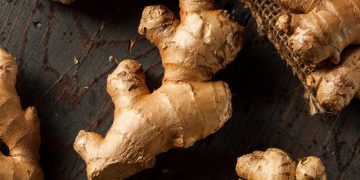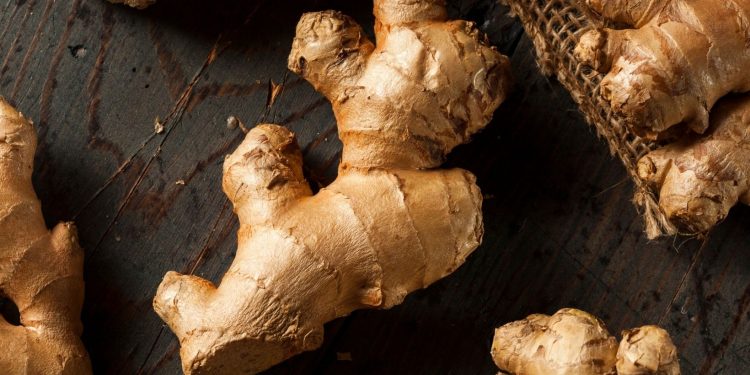Ginger Farming (Organic) Information Guide
The following article talks about “Ginger Farming” or “How to grow Ginger”.
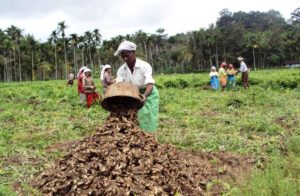
Introduction:
Ginger is a very important commercial crop grown for its aromatic rhizomes which are used both as a spice and a medicine. Ginger of commerce is the dried rhizome. It is marketed in different forms such as raw ginger, dry ginger, bleached dry ginger, ginger powder, ginger oil, ginger oleoresin, ginger ale, ginger candy, ginger beer, brined ginger, ginger wine, ginger squash, ginger flakes, etc. Ginger is the rhizome of Zingiber officinale Rosc., a herbaceous perennial belonging to Zingiberaceae, and is believed to be native of south-eastern Asia. It is propagated through rhizomes. The rhizomes put forth erect, leafy stems, 30-90 cm in height. The base of the leaves sheathe the stem. The leaves are dark green, 15-20 cm long, narrow, lanceolate and with a prominent midrib. The flowers are small, yellowish, speckled, each with a purple speckled lip and borne on a spike. When the plants are about 9 months old, the green leaves turn yellow. Ginger produced in India goes for domestic consumption and only a small quantity is exported.https://imasdk.googleapis.com/js/core/bridge3.510.1_ru.html#goog_268876080https://imasdk.googleapis.com/js/core/bridge3.510.1_ru.html#goog_268876082https://imasdk.googleapis.com/js/core/bridge3.510.1_ru.html#goog_268876084
Read: Ginger Cultivation Project Report.
An agro-climate requirement for Ginger growth:
Ginger grows in a warm and humid climate. It is mainly cultivated in the tropics from sea level to an altitude of above 1500 MSL and it can be grown both under rainfed and irrigated conditions. For successful cultivation, ginger requires a moderate rainfall at the sowing time till the rhizomes sprout, fairly heavy and well-distributed showers during the growing period and dry weather for about a month before harvesting.
Soil requirement for Ginger plantation:
Ginger thrives the best in well-drained soils like sandy or clay loam, red loam or lateritic loam. A friable loam rich in humus is ideal. However, being an exhaustive crop it may not be desirable to grow ginger in the same site year after year. It thrives well under partial shade, though it is also grown on a large scale in open areas.
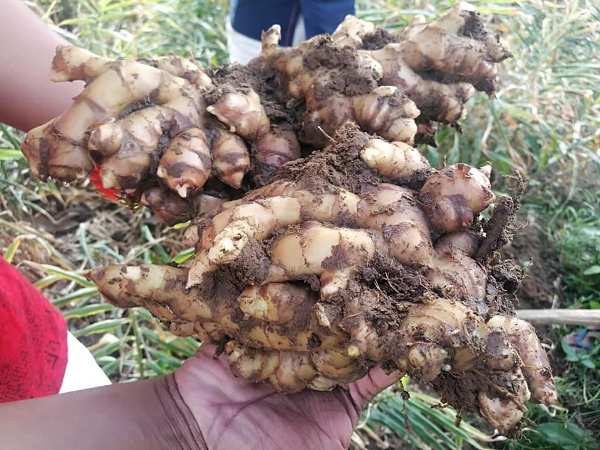
Inter-Crop in Organic Ginger Production:
Ginger can be cultivated organically as an inter or mixed crop provided all the other crops are grown following organic methods. It may be intercropped with shade-giving plants, e.g. banana, pigeon-pea, tree castor and cluster bean (guar). Ginger is grown as a mixed crop, in coconut, young coffee and orange plantations on the west coast. At higher altitudes in Himachal Pradesh, ginger is intercropped with tomato and chilli.
Buffer zone in Ginger Production:
In order to cultivate ginger organically, a buffer zone of 25 to 50 feet is to be left all around the conventional farm, depending upon the location of the farm. The produce from this buffer zone belt shall not be treated as organic. Being an annual crop, the conversion period required will be two years.
Land preparation for Organic Ginger Plantation:
While preparing the land, minimum tillage operations may be adopted. Beds of 15 cm height, 1 m width and of convenient length may be prepared to give at least 50 cm spacing between beds. Solarisation of the beds is beneficial in checking the multiplication of pests and disease-causing organisms. Solarisation is a technique by which moist beds in the field, are completely covered with polythene sheets and exposed to the sun for a period of 20-30 days. The polythene sheets used for soil solarisation should be kept away safely after the work is completed
Planting material of Ginger:
Carefully preserved seed rhizomes free from pests and diseases which are collected from organically cultivated farms can be used for planting. However, to begin with, seed material from high yielding local varieties may be used in the absence of organically produced seed materials. Seed rhizomes should not be treated with any chemicals.
Varieties of Ginger:
Several varieties are grown in different parts of India. China and Rio-De-Janeiro are the two imported varieties of ginger. Other important varieties grown are Maran, Assam, Himachal, Kuruppampadi, Wynad Local, Suprabha, Suruchi, Suravi, Himgiri, Varada, Mahima, Rajasthan etc. The best varieties suited for different products are;
| Varieties of Ginger in India | |
| High dry ginger | Maran, Nadia, and Karakkal |
| High oleoresin | Ernad Chernad, China, and Rio-De-Janeiro |
| High volatile oil | Sleeva Local, Narasapattam, and Himachal |
| Green ginger | Rio-De-Janeiro, China, Wynad Local, Maran, and Varadha |
Planting, Spacing of Ginger:
In Ginger Farming, at the time of planting, apply 25 grams of powdered neem(Azadirachta indica) cake and mix well with the soil in each pit. Ginger is planted in rows, 25 cm apart at distances of 20-25 cm within the row. In the case of the irrigated crop, ridges are made 40-45 cm apart and Ginger planting is done in shallow pits on top of the ridges at distances of 24-30 cm. Bits of seed-rhizomes weighing 20-30 g each and having at least one bud are planted at the given spacing. While planting, seed rhizomes mixed with well rotten cattle manure or compost mixed with Trichoderma ( 10 g of compost inoculated with Trichoderma) may be put in shallow pits and covered with a thin layer of soil and levelled. About 600-1000 kgs of seed-rhizomes is required to sow one acre of land. Higher seed-rates are used for planting at higher altitudes. Sowing is done in April-May in South India and a little later in North India. Sowing by the middle of April in the south and by the first week of May in the north gives higher productions.
The irrigated Ginger crop is watered immediately after sowing. The beds of the rain-fed crop are covered with leaf mulch as protection against sun and heavy rains and for consequent enrichment of organic matter in the soil. In some areas, farmyard manure is used as mulch. Seeds of cluster-bean, pigeon-pea or castor are sown on irrigation channels on the corners of the raised beds for shade. The shoots emerge in 10-20 days.
Irrigation requirement in Ginger Production:
Proper drainage channels are to be provided in the inter-rows to drain off stagnant water. Irrigation is given at varying intervals of 5 – 10 days as and when required.
Ginger Cultural practices:
Mulching ginger beds with green leaves is an important operation in ginger farming. Apart from being an organic manure, it helps in soil and water conservation. Mulching may be done with green leaves thrice in ginger, once immediately after planting @ 4 to 5 tonnes /acre to enhance germination, increase organic matter, and conserve soil moisture and prevent washing of soil due to heavy rains. It is repeated @ 2 tonnes /acre at 40th and 90th day after planting preferably at the time of weeding, hoeing and earthing up. Use of Lantana camara and Vitex negundo leaves as mulch may reduce the infestation of shoot borer. Cow dung slurry or liquid manure may be poured on the bed after each mulching to enhance the microbial activity and nutrient availability.
Weed Control in Ginger Plantation:
Two weedings are generally given to the crop. The first weeding just before the second mulching and repeated depending on the intensity of weed growth. The weeded material may be used for mulching. If necessary weeding is to be repeated a third time. Plants are earthed up once or twice.
Manuring Ginger Plants:
Ginger requires heavy manuring. Application of well rotten cow dung or compost @ 2.5 to 3 tonnes/acre may be made as a basal dose while planting the rhizomes in the pits. In addition, the application of neem cake @ 800 kg/acre is also desirable.
Pests and Diseases, Control Measures of Ginger Plants:
Shoot borer is the major pest infesting ginger farming. Regular field surveillance and adoption of phytosanitary measures are necessary for pest management. It appears during July -October period. Spot out the shoots infested by the borer and cut open the shoot and pick out the caterpillar and destroy them. Spray neem oil (0.5%) at fortnightly intervals if found necessary. Light traps will be useful in attracting and collecting the adult moths.
Soft rot or rhizome rot is a major disease of ginger farming. While selecting the area for ginger cultivation care should be taken to see that the area is well drained as water stagnation predisposes the plants to infection. Select seed rhizomes from disease-free areas since this disease is seed borne. Solarisation of soil done at the time of bed preparation can reduce the fungus inoculum. However, if the disease is noticed, the affected clumps are to be removed carefully along with the soil surrounding the rhizome to reduce the spread. Trichoderma may be applied at the time of planting and subsequently if necessary. Restricted use of Bordeaux mixture (1%) in disease-prone areas may be made to control it as a spot application.
Harvesting, Curing, and Yield of Ginger:
The Ginger crop is ready for harvesting in about 8 to 10 months depending upon the maturity of the variety. When fully mature the leaves turn yellow and the pseudostems begin to dry. Rhizomes are lifted either with a digging-fork or with a spade. They are cleaned of roots and adhering soil particles.

The green ginger is soaked in water to facilitate the removal of the skin. The skin is scraped off with pieces of sharpened bamboo. The scraped produce is washed and dried in the sun for 3 or 4 days and hand-rubbed. It is again steeped in water for two hours, dried and then rubbed to remove all the remaining bits of the skin. Sun-drying also bleaches the produce. Peeling should be done with great care and skill. The essential oil which gives ginger the aromatic character is present in the epidermal cells and hence excessive or careless scraping will result in damaging these cells leading to the loss of essential oils. Steel knives are not used as they are found to stain the produce. Storage of dry ginger for longer periods is not desirable. The yield of dry ginger is 15-25 percent of the fresh ginger depending upon the variety and location where the crop is grown. Burning of sulfur for processing ginger is not allowed.
The average yield of green ginger is estimated at about 6 to 10 tonnes per acre. The recovery of dry ginger varies from 16 – 25 percent.
Preservation of Ginger Seed:
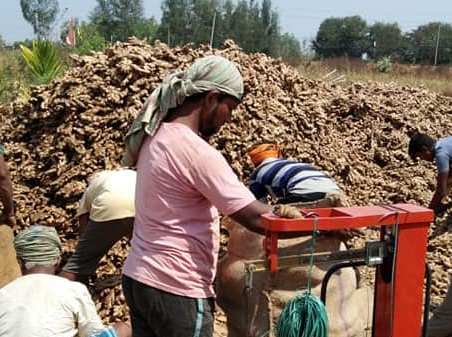
The rhizomes to be used as seed material should be preserved carefully. Indigenous practices like spreading layers of leaves of Glycosmis pentaphylla being followed by farmers can very well be adopted for this purpose. In order to get good germination, the seed rhizomes are to be stored properly in pits under shade.
For seed material, big and healthy rhizomes from disease-free plants are selected immediately after harvest. For this purpose, healthy and disease-free clumps are marked in the field when the crop is 6 – 8 months old and still green. Seed rhizomes are stored in pits of convenient size made in the shed to protect from the sun and rain. Walls of the pits may be coated with cow dung paste. Seed rhizomes are stored in these pits in layers along with well-dried sand/sawdust (i.e. put one layer of seed rhizomes, then put 2 cm thick layer of sand/sawdust). Sufficient gap is to be left at the top of the pits for adequate aeration. Seed rhizomes in pits need inspection once in twenty days to remove shrivelled and disease affected rhizomes. Seed rhizomes can also be stored in pits dug in the ground under the shade of a tree provided there is no chance for water to enter the pits. In some areas, the rhizomes are loosely heaped over a layer of sand or paddy husk and covered with dry leaves in thatched sheds.
Bottom Line of Growing Ginger:
Ginger Farming is the best profitable crop.
